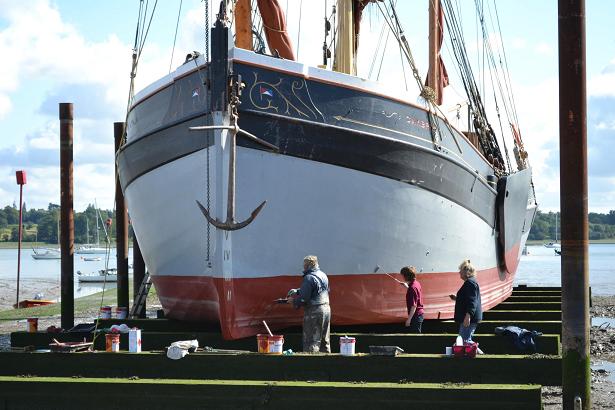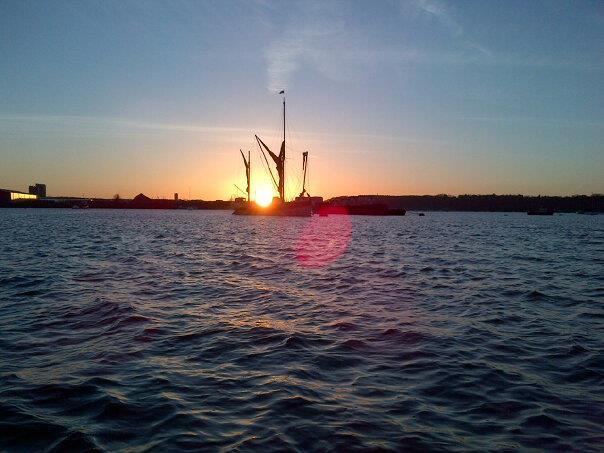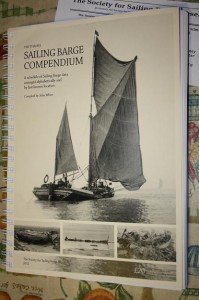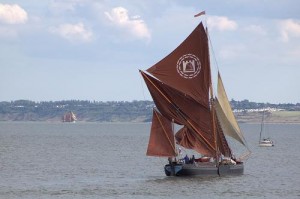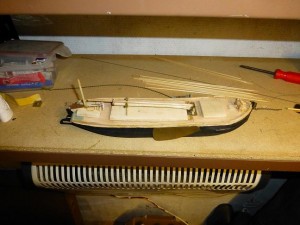
Dave and Tony Brooks’s Westmoreland Model as at Jan 2013; Photo by Dave B.
Model makers Dave and Tony Brooks send me an update on the progress on the Westmoreland model saying, “We did a little work on the model last week having had a break over Christmas due to family commitments. I have to say the weather was freezing but we did manage to complete a lot of the detail for the cabin top. We also made the mast case for the mizzen and attached our mini chaff cutter wheel. The picture shows the model with lee-boards temporarily attached and the masts in position but not fixed”. Nice one, Dave (and Tony)
In another unashamed ‘borrow’ from “The Barge Blog”, Tricia Gurnett’s on-line diary from the Society for Sailing Barge Research (SSBR) I also have some more detail about the Late Mark (Nozz) Boyle written by Richard Walsh. Fascinating stuff about a fascinating bloke, plenty of which I did not know even though I counted him as a friend and a colleague-volunteer.
Richard Walsh writes, “The sailing barge world was stunned by the recent news of the death at age 55 of Capt Mark Boyle,  the organising secretary of the Thames Sailing Barge Match, since it was revived by him to celebrate the 50th anniversary of V.E. Day in 1995.
the organising secretary of the Thames Sailing Barge Match, since it was revived by him to celebrate the 50th anniversary of V.E. Day in 1995.
Mark’s love of sailing barges was kindled by the gift of a model kit when he was a child. He built the model and was later taken to Maldon, Essex to see the real thing. To his disappointment he realised that his model was full of inaccuracies, and on returning home he set about putting it right!
Mark was a gifted historian with a wealth of knowledge on subjects as diverse as sailing barges and the Spanish Peninsular War. He was also a talented author, writing articles for magazines about the sailing barges and his experiences afloat, having ‘gone to sea’ in his teens in the coasting trade aboard ex. ‘sailormen’ by then trading under power alone. Through later years he crewed aboard the charter and hospitality barges that plied the coast, gaining his Sailing Barge Master’s ticket in 1987.
Not content with working aboard the last of the trading barges, Mark developed his shipwrighting skills which have left their mark on many of the genre. These include the Cabby, Dawn and, most recently, the magnificently restored Cambria to which he applied his talent and satisfied his barge preservation aspirations at the same time. He recognised that for the restoration movement to have lasting relevance, it is equally important to preserve the environment of the sailing barge. Sadly, the wharves and bargeyards have fallen prey to much questionable re-development, but Mark realised the equal importance of the ‘on the water’ activities, and saw an opportunity to contest the Championship of the London River again through the conduit of a revived Thames Sailing Barge Match.
The enormity of the task before him in restoring this, the original barge match, to its rightful place in the sailing barge calendar would have scuppered many a capable organiser. In the wake of the success of the 1995 race, there was an appetite for more. Mark sought out the families which had played their part 100 and more years ago, with the result that the iconic names of sailing barge owners Everard, Clarabut and Goldsmith became associated with the Match once again. The outcome of his effort and commitment is evidenced by the current series being the longest ever continuous revival of the race since its founding by Henry Dodd in 1863.
The sailing barge fraternity has lost one of its stalwart supporters and his passing will have a significant impact in many ways. The Thames Match committee has met and decided to continue with the organising of this year’s event, the 150th anniversary of the first, which will take place on Saturday 13th July and be known as The Mark Boyle Memorial Thames Sailing Barge Match in honour of his vision and dedication to a sailing contest almost as old as the America’s Cup”.
Thank you very much for that, Tricia Gurnett, Richard Walsh and the Society for Sailing Barge Research. Links to SSBR and The Barge Blog are available in our links page.
